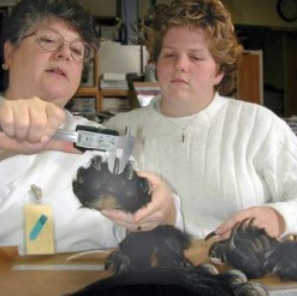What Does the Wildlife Crime Lab Do?
As with any crime lab, this facility has two jobs: first, to identify evidence; and second, to link the suspect and crime scene. Like standard police labs, it uses physical evidence such as fingerprints, tire tracks, bullets, gunshot residues, poisons and DNA to reveal what might have happened to its animal victims and to identify possible suspects. Yet it has an extra job: figuring out what the victim is.
The lab handles over 30,000 species of victims, which makes a regular police lab, with a mere one species to worry about, look like a vacation spot. The lab’s staff isn’t just working feverishly to conserve valuable wildlife, they are forging a new field of science as they go.
 Their work is complicated because they have no set procedural guidebook to follow, especially as victims often arrive as unidentifiable parts—a carved statuette, or a belt, or maybe a small vial of pills—and the tricks of good old-fashioned police work, like finding a reliable witness, don’t apply.
Their work is complicated because they have no set procedural guidebook to follow, especially as victims often arrive as unidentifiable parts—a carved statuette, or a belt, or maybe a small vial of pills—and the tricks of good old-fashioned police work, like finding a reliable witness, don’t apply.
Day to day, nobody knows what to expect. The lab rarely receives easily recognizable evidence, like a whole animal, but instead gets pieces, like bones, skins, or dried blood, or products, like powdered medicine. The victim’s identity is lost as all the things that would have told you “this is from an elephant” or “this is from a turtle” simply aren’t there.
The scientific problem is to reverse the manufacturing process by taking the processed product and figuring out what is unique to the part of the species that it supposedly contains. This is complicated, however, by non-standard production processes that make it difficult to know what other things might be mixed into the pot.
The lab’s scientists must also decide what approach to take. In contrast, regular crime labs can use tried and true technology to come up with results where they know the chance for error. For example, they routinely use DNA testing for rape cases to identify suspects. While infinite variations of DNA exist, the cases themselves fall into predictable patterns that let the labs employ standard techniques over and over. The wildlife crime lab is not20so lucky. Not only do its cases vary from one to the next, with powdered bear bile one moment and sturgeon eggs the next, but the more an item is processed, the less likely it is to have species defining characteristics. Hence, the lab’s main tasks are to figure out what techniques to apply to the evidence, identify a unique characteristic contained in the animal part in question, and then develop a methodology that finds that trait consistently. All of this takes time, often years, and requires a goodly amount of detailed knowledge of the species. That’s why, for all of the high-tech equipment available to the lab, nothing can ever substitute for human expertise. As the lab’s forensic ornithologist, Pepper Trail, put it, tapping his head, “This is still the most powerful instrument we rely on here.”
